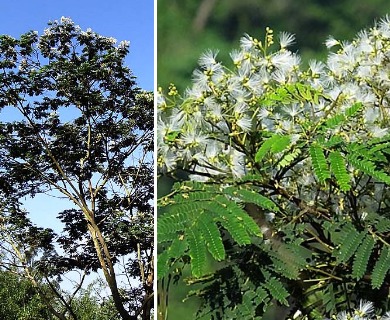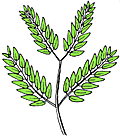Albizia
Falcataria falcata
Pea family (Fabaceae)
Post-Cook introduction
This is a large, introduced tree with a tall trunk and thin very broad spreading of large twice leaves. To 100 ft (30 ) tall, with a trunk diameter to 4 ft (1.2 ), not enlarged at the base. Bark is light gray, smooth with corky warts, showy. Inner bark is pink, astringent and slightly bitter. Twigs stout, light gray. Mimosa subfamily (Mimosoideae).

©2013 葉子 leaf0605
Flower clusters () are large, lateral, branched, 8–10 inches (20–25 ) long. Flowers many, clustered, stalkless, 1⁄2 inch (13 ) long, whitish, composed of light green bell-shaped 5- 1⁄8 inch (3 ) long, greenish white 1⁄4 inch (6 ) long with five narrow pointed very many theadlike spreading more than 1⁄2 inch (13 ) long, and slender with narrow and long threadlike
(pods) narrow, flat, 4–5 inches (10–13 ) long, 3⁄4 inch (2 ) wide, green, turning brown, thin-walled, splitting open. Seeds 15–20, beanlike, 1⁄4 inch (6 ) long, oblong, flattened, dull dark brown.
The heartwood is pale yellow brown with a pink tinge. Sapwood is white. Wood lightweight ( gr. 0.33), coarse-textured, and essentially unfigured. It has strength equivalent to ponderosa pine and machines well except for occasional fuzzy grain caused by tension wood. The lumber seasons well but is subject to staining unless dried rapidly. Dust from machining operations is very irritating to mucous membranes, both when the wood is green and when it is dry. The wood is non-resistant to decay or termites.
Over 1 million board feet of timber have been cut on the island of Hawaii. Most of it was made into corestock veneer, for which it is highly suited. It has also been used in lumber form for lightweight pallets, boxes, and shelving. It is also suitable for internal furniture parts. Tests in the Philippines indicate it is a good pulpwood.
Plants become established naturally in abandoned sugarcane fields as well as in the forest wherever there are seed trees. The tree reproduces prolifically in areas below 1000 ft (305 ) elevation with 80–150 inches (2032–3810 ) rainfall. The lightweight pods are blown by winds, and seeds are abundant. This species has very rapid growth, as much as 15 ft (4.5 ) a year, but has a short life. It does well on poor, heavy clay, moist soils. The tree is a nitrogen fixer. Fallen leaves improve the soil.
Introduced to Hawaii in 1917 by Joseph Rock as an ornamental and for reforestation, it is now naturalized. The largest stand is at the Moloaa Forest Reserve on Kauai where there are more than 5 million board feet of sawtimber. It may be seen near Lyon Arboretum in Manoa Valley and at Foster Botanic Garden on Oahu, at the Lava Tree State Park in Puna, Hawaii, and along roadsides and in gardens through the State. A stand in Palolo Valley, Oahu, had trees 27 inches (69 ) in diameter at only 13 years of age.
Champion
Height 110 ft (33.6 ), c.b.h. 29.8 ft (9.1 ), spread 167 ft (50.9 ). Hilo, Hawaii (1968).
Range
Native to Molucca
Other common name
sau
Botanical
Albizia moluccana Miq., A. (L.) Backer (in part), Paraserianthes falcataria (L.) Nielson, Albizia falcataria (L.) Fosberg











